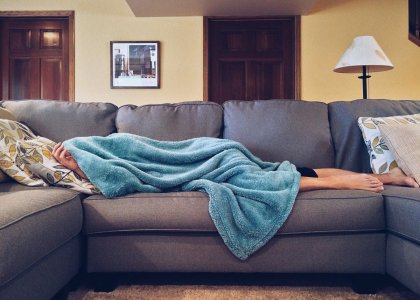Discover the health benefits of napping: is it better to take short or long snoozes?
By
- Replies 0
When it comes to everyday well-being, our sleep patterns are just as crucial as our diet and exercise habits.
However, understanding our need for sleep extends well beyond simply getting a full night's slumber.
As it turns out, our approach to daytime napping can also significantly impact our health. But, what's the optimal nap duration, and what unique benefits come with short versus long snoozes?
Although its benefits may be overlooked, taking a quick snooze during the day can be just the medium-term boost our bodies and brains need for us to get through the grind and make it to the weekend.
Dr Jen Walsh, Director of the Centre for Sleep Science at the University of Western Australia—shared some surprising facts about the benefits of catching a snooze versus a few minutes’ shut-eye.
What Does a Good Nap Consist of?
According to an ABC Health report, not all naps are the same, because not all sleep stages are the same. There are three different stages before we get to a steep of rapid eye movement (REM) sleep: N1, N2, and N3.
Napping can make a big difference in how alert and focused we feel over the day, but these benefits can depend on which stage of sleep we achieve during naps.
A short nap of about 20 minutes usually consists of N1 and N2 sleep; and a longer nap of about 40 minutes will see you enter N3, or slow-wave sleep, which is the hardest stage to wake up from.
‘If you wake up from that stage [N3] then you're more likely to go through a period of what we call sleep inertia,’ Dr Walsh says, ‘which is where you'll feel groggy.’
If you can manage to stay asleep around the 90-minute mark, you'll enter REM—and hopefully wake up feeling refreshed.
The Benefits of Having That Extra Snooze
Have you ever wondered why napping can make such a big difference in terms of how focused, alert and energised you feel later in the day?
While we're asleep, our brains exhibit short bursts of activity that help make and maintain important connections.
This increases our alertness, memory processing, mood and even physical performance.
Naps also deliver other health benefits—including lowered risks of having a heart attack or stroke.
A study out of Spain, where regular siestas are part of the lifestyle, revealed that those who take short naps (under 30 minutes) were 21 per cent less likely to have elevated blood pressure compared to those who didn’t take naps or who slept for longer durations.
So, What's the Perfect Nap Time?
Unfortunately, it's difficult to set an exact time frame for the ‘perfect’ nap. Dr Walsh points out that 'you can't set your watch by it'—and that timing depends greatly on the individual.
However, some general guidelines are useful—for example, keep naps to about 10-20 minutes if you're at work and you're experiencing a post-lunch slump. Naps of up to 20 minutes offer almost immediate cognitive benefits, which should last for around three hours or more.
If you have more time and you want to refresh ahead of a big night, an hour or so should do the trick—although you will have to wade through grogginess between 30 minutes to an hour.
Finally, napping won't make up for consistently not getting enough quality sleep. If you find yourself taking regular long naps, it's worthwhile ruling out underlying health conditions that can cause day-time sleepiness.
As Dr Walsh explains, a nap may offer short-term comfort, but recovering from prolonged sleep loss takes a lot of time.

What do you think of this story? Do you take short or long naps? Let us know in the comments below!
However, understanding our need for sleep extends well beyond simply getting a full night's slumber.
As it turns out, our approach to daytime napping can also significantly impact our health. But, what's the optimal nap duration, and what unique benefits come with short versus long snoozes?
Although its benefits may be overlooked, taking a quick snooze during the day can be just the medium-term boost our bodies and brains need for us to get through the grind and make it to the weekend.
Dr Jen Walsh, Director of the Centre for Sleep Science at the University of Western Australia—shared some surprising facts about the benefits of catching a snooze versus a few minutes’ shut-eye.
What Does a Good Nap Consist of?
According to an ABC Health report, not all naps are the same, because not all sleep stages are the same. There are three different stages before we get to a steep of rapid eye movement (REM) sleep: N1, N2, and N3.
Napping can make a big difference in how alert and focused we feel over the day, but these benefits can depend on which stage of sleep we achieve during naps.
A short nap of about 20 minutes usually consists of N1 and N2 sleep; and a longer nap of about 40 minutes will see you enter N3, or slow-wave sleep, which is the hardest stage to wake up from.
‘If you wake up from that stage [N3] then you're more likely to go through a period of what we call sleep inertia,’ Dr Walsh says, ‘which is where you'll feel groggy.’
If you can manage to stay asleep around the 90-minute mark, you'll enter REM—and hopefully wake up feeling refreshed.
The Benefits of Having That Extra Snooze
Have you ever wondered why napping can make such a big difference in terms of how focused, alert and energised you feel later in the day?
While we're asleep, our brains exhibit short bursts of activity that help make and maintain important connections.
This increases our alertness, memory processing, mood and even physical performance.
Naps also deliver other health benefits—including lowered risks of having a heart attack or stroke.
A study out of Spain, where regular siestas are part of the lifestyle, revealed that those who take short naps (under 30 minutes) were 21 per cent less likely to have elevated blood pressure compared to those who didn’t take naps or who slept for longer durations.
So, What's the Perfect Nap Time?
Unfortunately, it's difficult to set an exact time frame for the ‘perfect’ nap. Dr Walsh points out that 'you can't set your watch by it'—and that timing depends greatly on the individual.
However, some general guidelines are useful—for example, keep naps to about 10-20 minutes if you're at work and you're experiencing a post-lunch slump. Naps of up to 20 minutes offer almost immediate cognitive benefits, which should last for around three hours or more.
If you have more time and you want to refresh ahead of a big night, an hour or so should do the trick—although you will have to wade through grogginess between 30 minutes to an hour.
Finally, napping won't make up for consistently not getting enough quality sleep. If you find yourself taking regular long naps, it's worthwhile ruling out underlying health conditions that can cause day-time sleepiness.
As Dr Walsh explains, a nap may offer short-term comfort, but recovering from prolonged sleep loss takes a lot of time.
Key Takeaways
- The perfect length for a nap varies depending on factors such as individual sleep patterns and circumstances.
- Short naps of around 20 minutes can lead to immediate cognitive benefits, but there can be a period of 'sleep inertia' or grogginess after longer naps.
- Prolonged napping doesn't replace the need for sufficient quality sleep at night to avoid health risks associated with 'sleep debt'.
What do you think of this story? Do you take short or long naps? Let us know in the comments below!








